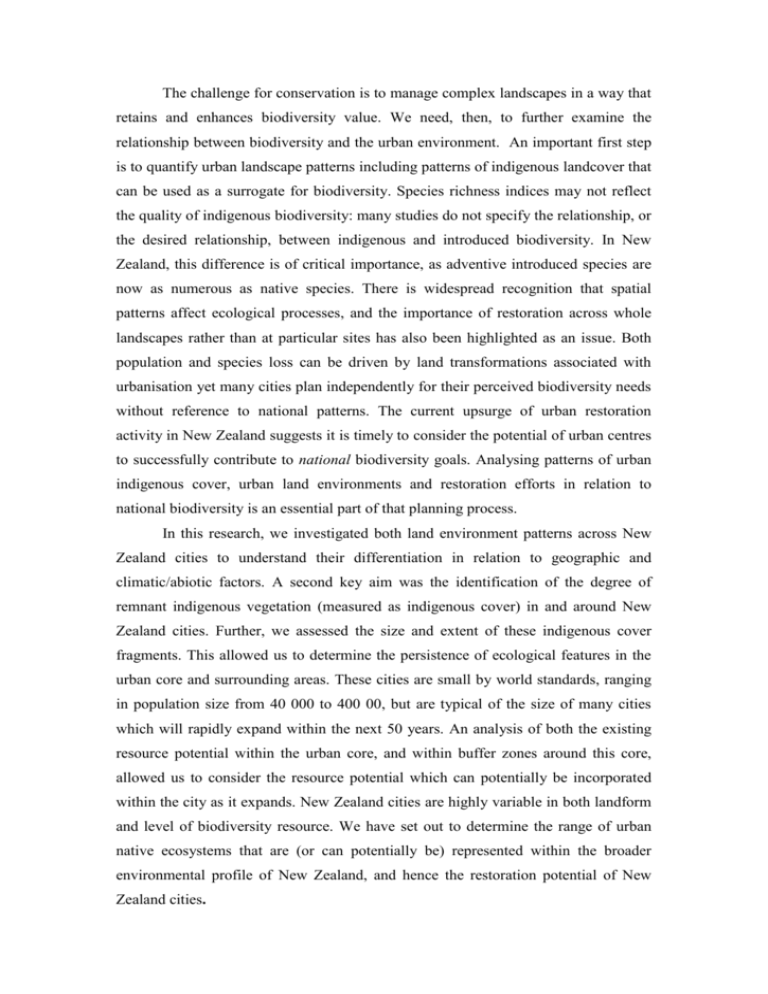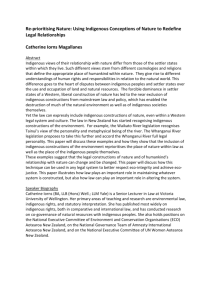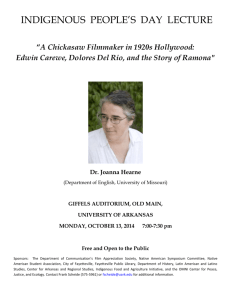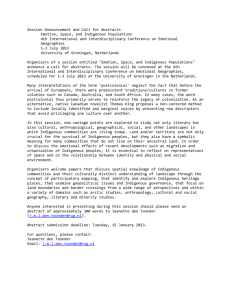The challenge for conservation is to manage complex landscapes in
advertisement

The challenge for conservation is to manage complex landscapes in a way that retains and enhances biodiversity value. We need, then, to further examine the relationship between biodiversity and the urban environment. An important first step is to quantify urban landscape patterns including patterns of indigenous landcover that can be used as a surrogate for biodiversity. Species richness indices may not reflect the quality of indigenous biodiversity: many studies do not specify the relationship, or the desired relationship, between indigenous and introduced biodiversity. In New Zealand, this difference is of critical importance, as adventive introduced species are now as numerous as native species. There is widespread recognition that spatial patterns affect ecological processes, and the importance of restoration across whole landscapes rather than at particular sites has also been highlighted as an issue. Both population and species loss can be driven by land transformations associated with urbanisation yet many cities plan independently for their perceived biodiversity needs without reference to national patterns. The current upsurge of urban restoration activity in New Zealand suggests it is timely to consider the potential of urban centres to successfully contribute to national biodiversity goals. Analysing patterns of urban indigenous cover, urban land environments and restoration efforts in relation to national biodiversity is an essential part of that planning process. In this research, we investigated both land environment patterns across New Zealand cities to understand their differentiation in relation to geographic and climatic/abiotic factors. A second key aim was the identification of the degree of remnant indigenous vegetation (measured as indigenous cover) in and around New Zealand cities. Further, we assessed the size and extent of these indigenous cover fragments. This allowed us to determine the persistence of ecological features in the urban core and surrounding areas. These cities are small by world standards, ranging in population size from 40 000 to 400 00, but are typical of the size of many cities which will rapidly expand within the next 50 years. An analysis of both the existing resource potential within the urban core, and within buffer zones around this core, allowed us to consider the resource potential which can potentially be incorporated within the city as it expands. New Zealand cities are highly variable in both landform and level of biodiversity resource. We have set out to determine the range of urban native ecosystems that are (or can potentially be) represented within the broader environmental profile of New Zealand, and hence the restoration potential of New Zealand cities. Methods Two databases were analysed – The Land Environments of New Zealand (LENZ) database developed by Landcare Research, and the Landcover Database 2nd edition (LCDB(2)) data set. LENZ uses environmental variables such as rainfall, water vapour pressure, mean annual temperature and minimum annual temperature to build a picture of the land environment which existed prior to human settlement in around 1200 AD. It has four levels which vary from the general to the detailed. LENZ level 1 is useful for identification of general patterns of which land environments are represented in cities, while LENZ level 4 is the most detailed level of analysis which is most appropriate for environmental profiles and the examination of land environments in cities. LCDB(2) is a database which quantifies current landcover across New Zealand. It is derived from LANDSAT 7 imagery with a 15m pixel resolution. We have used data on indigenous landcover from this database as a surrogate for biodiversity. The Landcover classification has approximately 50 classes, such as broadleaved indigenous hardwood, tall tussock grassland, and subalpine shrubland. A generalised landcover data set was developed from the initial landcover data set by combining classes. Although there are some discrepancies and incorrect assignment of LCDB(2) classes this database is the best available in New Zealand. We have focused on general trends in land categorisation rather than absolute values, so that the requirement for data accuracy is more relaxed than might otherwise be the case. We therefore consider the results robust. Urban areas were initially identified using Statistics New Zealand’s urban regions with a population greater than 40,000 based on the 2001 population census. Twenty cities were identified for analysis. We then classified urban as an urban area based on a contiguous algorithm to construct an ‘urban core’, to allow us to compare structurally/ ecologically equivalent parts of the city rather than just variable historical administrative units, hence precluding the use of city boundaries. Results Underlying urban land environments Thirteen of 20 land environments at the most generalised level of LENZ occur within the urban cores of the largest 20 cities. Most cities have more than one land environment represented, with the most common number of land environments being two or three. Nonetheless, one land environment frequently tends to predominate in each city. The range and diversity of environments emphasises the need for each city to put in place individual solutions to biodiversity retention. A more detailed analysis of land environments at Level IV of LENZ shows that 100 of 500 identified land environments lie beneath core urban areas, increasing to 181 in the 5 km buffer zone, and 214 in the 10 km buffer zone. Using the five threat categories for indigenous land environments in New Zealand that have been identified (acutely threatened, chronically threatened, at risk, critically underprotected, underprotected, and a further category of no threat, the urban cores comprise 63 different acutely threatened land environments (which make up 66% of the land area) and 13 chronically threatened environments. Within the 5 km buffer zone around the urban core, the number of acutely threatened land environments increases to 83, representing 52.5% of all acutely threatened environments on a national scale. Sixty acutely threatened land environments (38% of all acutely threatened land environments) have more than 10% of their potential land area within the total urban and periurban area defined at its outer limits by the 20 km buffer zone. Twenty-two acutely threatened environments have more than 50% of their possible area represented within these urban and periurban zones, and six acutely threatened land environments have more than 90% of their total land extent within 20 km of the urban cores of cities. Remaining indigenous landcover in the urban and periurban zones The percentage of indigenous cover remaining within the urban core of cities ranged from 0-8.9% ( x = 1.96%). As expected, the amount of remaining indigenous cover increased with distance from the urban core, with the greatest amount of indigenous cover, on average, in the 20 km zone. The pattern of indigenous cover through the urban and periurban zones from the central urban core varies. Three distinct patterns of increasing indigenous cover were revealed along the buffer zone gradient from the urban core to 20 km. The number of indigenous landcover types represented in each zone significantly increased with distance from the city centre. Of the indigenous terrestrial landcover, only broadleaved hardwoods and forest occur in more than half of the urban centres; at the other extreme, flaxland and herbaceous freshwater vegetation are both recorded in only one city each. Unusual indigenous biodiversity is also represented within 5 km of the urban cores. Discussion This is the first meta-analysis of indigenous landcover in New Zealand cities and reveals national patterns of landcover which have not previously been identified, including the degree of remnant indigenous landcover in urban centres. Urban centres are situated most often in the lowland coastal environments which are known to have the greatest number of threatened species and environments. The majority of land environments in New Zealand are represented to some degree within cities, including 215 different acutely threatened environments. Three well defined generalised gradient patterns of increasing quantity of indigenous cover occur from the urban core to the periurban areas and the number of indigenous cover types also increases significantly within a 20 km buffer zone around the centre. Most New Zealand cities occur within the North Island, with most large cities occurring in the North Island northern lowlands environment. The New Zealand flora has a high degree of rarity (c.22%), and there are unexpectedly large numbers of threatened taxa in the lowland zone. The high number of landcover types represented within 20 km of cities, and the small extent of indigenous landcover that remains on acutely threatened land environments, suggests that particular care is needed to protect these remnants. As yet the value of natural ecosystems in cities is poorly known, as many cities do not have inventories or databases which quantify these areas. Co-operative partnership with regional administrators and planning within a national urban biodiversity framework has the potential to significantly enhance the national biodiversity resource. Currently, large remnant areas tend to be close to the city boundary, and hence are rarely situated within the urban core. This has implications for future urban growth; these areas with large indigenous patches tend to be in ‘dynamic’ landscapes where the landscape continues to be modified and communities may be in transition. The city centre however, requires a different approach for restoration of biodiversity with its more ‘static’ landscape and larger degree of fragmentation. Protection of large fragments in the periurban zone is clearly the best way to ameliorate some of the effects of small fragment size in the urban core. We consider that restoration or protection of existing indigenous fragments is not enough to protect biodiversity. Reconstruction of indigenous ecosystems will be required. Reconstruction of ecosystems requires a different approach from restoration, including research direction. We emphasise the need for an explicit analysis of the indigenous resource available as opposed to a laissez faire or ad hoc approach. New Zealand has a strong record in wildland ecology research which can be reconfigured to meet these issues. Cities offer special opportunities for conserving biodiversity that are not available elsewhere, and these opportunities are particularly pertinent for areas with highly vulnerable endemic flora and fauna which are susceptible to foreign invasion. The concentration of people makes for a huge potential volunteer base; the complete absence of grazing animals enables undergrowths and ground covers rare in many wildland ecosystems; the lack of grazing and other threats provides opportunities for establishing populations of threatened plants struggling in their natural habitat; and the juxtaposition of people and biodiversity resources enables more efficient and effective activities such as education about biodiversity and the environment, cultural harvesting by native peoples and so on. Despite many species being poorly adapted to human dominated systems, solutions to some of these problems are also achievable with further urban ecological research. The analysis presented in this study indicates that biodiversity decline must be addressed in a systematic and considered way if substantial progress towards the retention of indigenous biodiversity is to occur.






